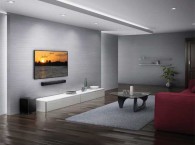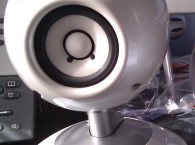Primax Acquires 70% Share of Tymphany
Primax Electronics, based in Taiwan and founded in 1984, will acquire a 70% share in Tymphany. Hong Kong, China-based Tymphany is an ODM and OEM speaker supplier for home, car, and pro audio brands. The acquisition is expected to be completed by the end of the year following regulatory approvals. Terms weren’t disclosed.
Tymphany has a proven record of success with a healthy margin and balance sheet. The company has been growing at a pace of 40% a year for the past two years. Primax COO Brian Yang said he expects the acquisition to significantly contribute to Primax’s revenues and earnings next year.
Tymphany said it will continue to operate as an independent company but will benefit from the Primax’s technology offerings and manufacturing capabilities. Primax, which is said to be the world’s largest PC peripheral equipment manufacturer, sells products under its own brand name. It is also an ODM and OEM supplier.
Tymphany, with administrative offices in Sausalito, CA, will retain its existing 2,500-employee work force, partner relationships, and management, including Tom Jacoby, chairman and corporate development officer. Tymphany also owns Peerless, an OEM supplier of speaker transducers.
Primax said the acquisition will help expand its presence in the digital audio market, including Bluetooth speakers, digital music players, wireless audio systems, and so forth. “We believe the combined strength of the audio and acoustic technology of Tymphany and the wireless and electronics manufacturing expertise of Primax will put us in the leading position of serving the needs of the digital audio industry,” according to Primax chairman/CEO Raymond Liang.
With the acquisition, Primax also receives a majority stake in several factories and R&D centers in South China. Tymphany’s 2,500 employees are located throughout China, Europe, and the US.
AudioXperts Closes Due to Lack of Funding
Luxury-audio startup AudioXperts closed its operations October 11, 2013. However, some of its products may make their way into the consumer electronics (CE) market. Eli Harary, AudioXperts founder and industry veteran, explained that the company’s majority investor, a Taiwan-based company with factories in mainland China, stopped funding AudioXperts after reaching an agreed-upon investment level. The investor decided to discontinue funding even though most of AudioXperts’s delayed product line was coming to market almost a year later than planned.
Unfortunately, AudioXperts reached its investment cap due to design, engineering, and build delays. One product, a TV sound base, was recalled due to quality issues. Other products had to be reworked to meet quality levels. This is not uncommon. coNEXTion Systems, a former CEDIA HT and distributed audio startup, closed for similar reasons (although it did not experience quality control issues).
It seems some Chinese companies that invest in US CE startups don’t understand the way the US does business. This is unfortunate since the potential for success when combining US engineering and marketing with China’s manufacturing can be powerful.
Although Harary explained to the investor’s board that most products were just now coming to market, the board was not willing to continue funding the company. As for the brand’s future, Harary said it is possible, but unlikely, that he will find another investor to operate the company as it was. However, he noted that perhaps the product designs and tooling may be sold to another company that could bring the products to market. AudioXperts attended this year’s CEDIA Expo to promote its new products. Unfortunately, the majority of AudioXperts’ employees have been permanently laid off.
Leon Speakers Acquires Media Décor
Founded in 2003, Media Décor manufactures high-end concealment products, including art lifts, moving art, and flat screen TV mounts. Leon Speakers acquisition of Media Décor expands its portfolio of high-end, custom-tailored loudspeakers with TV enhancement solutions and provides new commercial and residential business opportunities.
Lenbrook Launches Bluesound Brand
Lenbrook Industries has launched a new brand called Bluesound. The Bluesound designs are the company’s first wireless multi-room audio products, specifically positioned to be a step up from the Sonos brand’s wireless-audio systems in performance and price. Lenbrook, which markets audio components and speakers under the NAD and PSB brands, is pursuing a more limited distribution strategy than Sonos, targeting about 100 A/V specialists. Lenbrook is also exploring an opportunity with Magnolia Home Theater and Magnolia Design Center stores.
Bluesound’s first five products have already been delivered to approximately 40 A/V specialists in the US, primarily current NAD or PSB dealers. After the International CES in January 2014, the company plans to expand distribution to about 100 specialists and possibly Best Buy’s Magnolia Home Theater, which sells NAD and PSB headphones but not NAD or PSB audio components.
An engineering team that included most of Lenbrook’s NAD and PSB engineers developed this new product line, and the company is promoting the new brand’s connection to the NAD and PSB brands’ hi-fi heritage. Bluesound is targeted to music enthusiasts who are unfamiliar with the types of audio components made by companies such as NAD/PSB but who are interested in high-performance audio.
Product development began a little more than three years ago with a mission to create an accurate and musical sounding brand that would attract a broad audience of music enthusiasts, not just audiophiles. The concept was to target music enthusiasts who like the convenience of wireless and are willing to pay more for serious hi-fi performance.
The Bluesound product line includes the $699 Power Node streamer/amplifier, the $449 Node streamer without an amplifier for connection to existing sound systems, the $699 Pulse active biamplified tabletop speaker/streamer, and the $999 Vault streamer/ripper, which also lacks an amplifier. The brand offers the $999 Duo 2.1 speaker system. It can be used with the Power Node, which features an EQ switch to optimize playback through the Duo.
The streaming products, which use Apple and Android mobile devices as system controllers, stream music over a home network via 802.11 b/g/n or via wired Ethernet from a networked PC, Mac, or NAS drive, none of which need to run Bluesound software or use Digital Living Network Alliance (DLNA) technology. The devices also stream music from the brand’s Vault, which combines a wired streamer with a CD ripper, and 1TB of storage for music files ripped in the MP3 and lossless FLAC formats.
All the products also incorporate the TuneIn app, which streams music from radio stations worldwide and from the radio music service. Additional music services will be added as the brand progresses. The Vault also streams from a networked computer, similar to the Sonos motif. When a USB-connected Bluetooth dongle is plugged into the Bluesound streamers, users will be able to stream music from a mobile device to the Bluetooth-connected component, which in turn will retransmit the music via Wi-Fi around the house to the other Bluesound streamers.
Triad Releases New Behind-Wall Speakers

Photo 1: Triad Speakers’s new DS700se is a behind-wall, two-way speaker designed for larger rooms or theaters requiring more output and highly dynamic sound quality.
Triad Speakers has released an upgrade to its behind-the-wall Invisible Designer Series Speakers. The new DS700se is Triad Speakers’s first two-way model behind-wall speaker (see Photo 1). It features wider frequency response from 50 Hz to 20 kHz, deeper bass, improved midrange and treble response, and 200-W peak per channel power handling.
The DS700se, which joins seven single-panel models, consists of two separately mounted flat vibrating honeycomb panels per channel, one panel for lows and one for highs.
The other Designer speakers use one full-range panel per channel. As with previous designs, the rigid aluminum-honeycomb panels are cut into the wall, and their paper skins are covered with plaster, drywall compound, or mud skims to completely hide the speakers by blending them into the wall. The DS700se panels fit between the wall studs in typical home construction and require a mounting depth of only 2”.
The flat-panel technology enhances off-axis response when compared with traditional speakers. This is true, in part, because the radiating panels are larger in size than a typical driver, according to Triad engineer David Nelson. Separate placement of low- and high-frequency panels also makes placement more flexible to deliver the best imaging, Nelson added. The high-frequency panel measures 17.7 ” × 13.6” × 1.6” and the low-frequency panel measures 17.7 × 7.9 × 1.6.”
The panel costs $2,250 per channel, which includes a HPF-2 limiter/filter protection unit. For more information, visit www.triadspeakers.com.
NTI America Celebrates 10th Anniversary
NTI Americas is marking its 10th anniversary serving North, Central, and South America with NTi Audio products and services. The formation of NTI Americas was announced 10 years ago at the 2003 New York AES convention.
The company provides factory support, sales, parts, service, and ISO calibration for all NTi Audio test equipment in the entire western hemisphere of North, Central, and South America as well as the Caribbean and other island locations.
Located in Tigard, a suburb of Portland, OR, NTI Americas represents NTi Audio at trade shows and technical conferences each year in the US and Canada. Its Oregon facility includes state-of-the-art calibration, electronic measurement equipment, and parts providing everything from a quick check up on an NTi Audio instrument to a complete overhaul and re-calibration.
During the past decade, NTI Americas has developed clients all over the hemisphere. In addition to the major pro audio, recording, and broadcast companies, other customers include major mobile device and telecommunication manufacturers and software companies, universities, colleges, research labs, production facilities, performance venues, aerospace, scientific, and military clients (e.g., NASA, NOAA, Boeing, Lockheed-Martin, Embraer, and the armed services).
In recent years, there has been major growth in the environmental, community noise, and life safety/security areas, leading to clients ranging from environmental agencies to the major transit systems. According to Thomas E. Mintner, president and owner of NTI Americas, “We’re grateful that over the last 10 years, NTi Audio has provided us with a continuous and growing portfolio of new high technology audio and acoustical measurement products to serve a wider and wider range of noise, audio and acoustics-oriented users.” For more information, visit www.ntiam.com.
CEA Study Shows 38% of Consumers Use Multiple Channels for Purchases
About 38% of brick-and-mortar shoppers end up making their consumer electronics (CE) purchases at retailers’ websites, according to a new CE study. The report, from the Consumer Electronics Association (CEA), also indicates that just under half (45%) of brick-and-mortar customers use their mobile devices to help them shop while in stores, and 4% will use them to make a purchase.
Still, brick-and-mortar stores retain the bulk of visitor business with 69% of purchases. What’s more, 86% of CE storefront shoppers said they use physical showrooms for product examination and returns, and 84% said they make purchases there.
The study also indicated that 89% of CE buyers use retailers’ websites to compare prices and read product reviews, while 84% compare product features online. Among those using mobile devices while shopping in stores, 54% access them to search for product information, 46% compare in-store prices with e-tailers, 42% compare the retailer’s in-store and online prices, and 42% price shop other physical retailers.
The study concluded that 38% of CE shoppers use a physical retailer’s online channels when looking to buy a CE product.
According to Rhonda Daniel, CEA’s senior manager for market research, it is imperative that physical CE retailers have a well-defined multi-channel strategy. Creating seamless and fluid relationships across channels (websites and showrooms) will enable physical retailers to play an integral and uninterrupted role along the entire path to purchase. The complete study, “Multi-Channel Alignment for CE Retailers with Physical Stores,” is available free to CEA member companies at Members.CE.org. Non-members may purchase the study for $999 at the CEA store.
Holiday Sales Predicted to Rise
Holiday sales are expected to increase 3.4% from last year, according to a new retail report by the trade group International Council of Shopping Centers (ICSC). The ICSC report maintained that its November to December forecast is up slightly from the 2012 holiday season, even though retailers are anticipating more modest sales. Despite the mixed outlook, and the economy’s “mini-cycle slowdown” over the last three quarters, this year’s holiday sales environment is looking up, according the ICSC.
Along with reduced price discounting, ICSC is also projecting a 13% increase in online and other direct sales this holiday season. Additionally, holiday hiring, which directly correlates to holiday spending and can often help forecast a stronger sales performance, is set to grow 0.5% over last year’s holiday hiring.
The ICSC’s 3.4% forecast comes in right between two previous sales projections. Earlier this month, ShopperTrak, a global retail sales consultancy, projected a 2% increase in holiday sales for November and December, while Deloitte, a financial consulting company, forecasted a gain of as much as 4.5% for the November to January period.
NEAR Returns to Consumer Products

Photo 2: NEAR’s residential bracket-mounted speakers are designed for outdoor use. (Photo courtesy of NEAR)
New England Audio Resource (NEAR) returned to the CEDIA Expo (September 25—28, 2013 in Denver, CO) for the first time in 14 years to launch a line of all-environment speakers and a companion amplifier for residential applications. Based in Gardiner, ME, NEAR has been focusing on the commercial speaker products following its acquisition by Bogen Communications in 1999. Based in Ramsey, N.J., Bogen Communications is a commercial audio products supplier. Since its acquisition, NEAR’s lineup had been aimed primarily at commercial applications, though NEAR products did sometimes cross over into residential channels when Bogen distributors sold to residential contractors.
Now, NEAR is reentering the residential market, according to NEAR founder and chief product engineer Bill Kieltyka. With consumers growing interest in outdoor audio, NEAR thought it was time to launch an entirely new line designed specifically for the residential contractor.
Although NEAR has essentially been out of the residential channel for more than a decade, the company has been continually advancing its knowledge of what it takes to produce audiophile-grade speakers that can withstand the most brutal conditions in all environments. Developing outdoor speakers for commercial applications enabled the company to take its spider-less, magnetic-suspension metal-cone drivers to new levels of reliability under the most brutal conditions.
The new NEAR residential products include four full-range bracket-mounted speakers—the LB 4, the LB 5, the LB 6, and the LB 8 (see Photo 2). The lineup also includes three full-range speakers designed to be partially buried in the ground—the IG 5, the IG 6, and the IG 8—and the 12” IGS 12 subwoofer.
The new speakers use NEAR-developed spiderless magnetic-fluid suspension woofers. The full-range models are two-way coaxial models with aluminum-dome drivers. The line also includes a 2 × 600-W 6XL amplifier designed for use with the NEAR speaker systems. It features onboard selectable high- and low-pass filters for use in outdoor systems that include a subwoofer. The 6XL drives both 70-V and 8-O speakers, thanks to a transformer-less output topography. The LB models are available in black or white. The IG and IGS models are available in a terra-cotta color.
Cosmetically, NEAR’s new speakers feature designs from Allen Boothroyd’s design studio. The LB models, for example, use an unusual lever-locking system and pre-terminated connection leads to make installation and positioning easier and safer.
The IG and IGS models feature a “bee-hive” shape that provides security when partially buried. However, the design also lends itself to freestanding applications.
KEF Releases THX Architectural Speakers

Photo 3: KEF now offers architectural speakers, including the Ci5160RL-THX. (Photo courtesy of KEF)
KEF officially added its name to the short list of loudspeaker manufacturers that are offering THX-certified architectural speakers (only two other companies—Klipsch and Atlantic Technology—offer THX architectural speakers). KEF’s new products consists of two THX Ultra2 in-wall left, center, or right (LCR) speakers due in January, an Ultra2 round in-ceiling speaker due in December, and an in-wall subwoofer due in January. Two subwoofers used together will qualify for Select2 certification, and four subwoofers will deliver Ultra2 THX performance.
The two three-way LCRs are somewhat unique and use an aluminum front baffle with a perforated-metal bezelless grille. Optional black and white fabric grilles leave a quarter-inch of aluminum exposed around the baffles’ perimeter as an aesthetic option. One of the LCRs, the Ci5160RL-THX, retails for $3,000 each, and the smaller Ci3160RL-THX retails for $1,700 each.
The Ci5160RL-THX contains four 6.5” woofers and a 6.5” midrange with a concentrically mounted tweeter based on KEF’s UniQ design (see Photo 3). The Ci3160RL-THX has two 6.5” woofers and a 6.5” midrange with a concentrically mounted tweeter. The required cutout is 8.2” × 26”. The round in-ceiling speaker is the two-way $800—each Ci1200RR-THX with 8” woofer and concentrically mounted 1.5” dome tweeter. The speaker features a narrow-bezel grille.
The in-wall subwoofer is the Ci3160RLb-THX with three vertically arrayed 6.5” woofers on an aluminum baffle. The $1,000-each subwoofer is matched to a $1,000-each 2 × 250-W KASA500 amplifier that can drive two subwoofers simultaneously. The rack-mountable Class-D amplifier incorporates DSP for active equalization. The amplifier and the subwoofer will be available in January.
Artison’s New In-Wall Subwoofers

Photo 4: The RCC 320 PC uses two pairs of 4” × 6” drivers to fit in a standard wall and to provide a reactance-canceling configuration. (Photo courtesy of Artison)
Artison recently unveiled four new in-wall active subwoofers, all with dual drivers in a reactance-canceling configuration to prevent cabinet and wall vibrations. Non-mass concealing in-wall subwoofers produce cabinet and wall vibrations that reduce audio output and clarity, not to mention disturb people in adjoining rooms. The subwoofers fit flush in standard 2 × 4 walls.
The four models include the $900 RCC 320 PC (see Photo 4) and $1,500 RCC 640 PC, both for preconstruction installations, and the $900 RCC 320 R and $1,500 RCC 640 R for retrofit applications. Their companion subwoofer amplifier is the $800 RCC 620 SA. The amplifier and the 320 models ship in October, and the 640 models ship in November.
They all feature all-aluminum enclosures, IP 65 waterproof rating for high-moisture environments, high-efficiency drivers with extended throw to produce accurate extended bass, and low-profile decorator grilles. The amplifier can drive multiple subwoofers at a time. However, the enclosures are small to increase application options without sacrificing performance, according to the company, which is owned by Cary Christie, one of Infinity’s original founders.
To reduce the size to fit in a standard wall and to provide a reactance-canceling configuration, the RCC 320 PC and RCC 320 R use two pairs of 4” × 6” drivers, while the other two subwoofers use four pairs of 4” × 6” drivers. Each pair of drivers faces each other inside the cabinet, and sound is vented through a horizontal slot in the baffle.
In the preconstruction models, only a narrow grille that covers the vent is visible to homeowners. The retrofit models use larger grilles. The paired drivers are driven in phase so that cone motion is in unison, but physically out-of-phase, thus canceling each driver’s reactive forces, according to Christie. The configuration also enables the use of smaller, lighter, more accurate drivers that are collectively more efficient and have more power handling capacity than a single larger driver. An all-aluminum enclosure was chosen because of its stiffness and thinness, which maximizes interior volume.
The outboard rack-mount Class-D amplifier delivers 400 WRMS into one subwoofer and 600 WRMS into two subwoofers. It features DSP-based preamplifier, music, and movie modes selectable via amplifier IR codes, 0°-to-180° digital phase-shift adjustment, signal-sensing on/off, 12-V triggers, IR jack, balanced XLR input, and adjustable low-pass crossover from 40 to 160 with 12 and 24-dB/octave cutoff slopes.
Separately, Artison is showing a new custom-installed speaker designated for rear- or side-surround applications.

Photo 5: Artison’s new Mezzanine 8 speaker is designed for in-wall or in-ceiling placement. (Photo courtesy of Artison)
The Mezzanine 8 speaker is designed for in-wall or in-ceiling placement (see Photo 5). It is shipping at $600 per pair. It joins a LRSIW in-wall speaker designated for left, right, and surround applications.
The Mezzanine’s four drivers consist of two mid-woofers and two silk-dome tweeters in a sealed enclosure. The tweeters are mounted at a 60° angle to one another and are wired out of phase to create a nondirectional acoustic pattern above 3 kHz, enveloping listeners “in three-dimensional space,” the company said.
The dual mid-woofers are wired in-phase to generate a point source to provide precise locations for action and reality scenes. The enclosure is molded in ABS plastic with glass fiber for strength and durability. Mounting depth is only 3.5”. It ships with a round, paintable grille for in-ceiling use and an optional square grille for wall placement.









